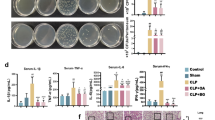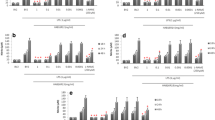Abstract
Background
Major symptoms and death from systemic Bacillus anthracis infections are mediated by the action of the pathogen’s lethal toxin on host macrophages. High levels of the toxin are cytolytic to macrophages, whereas low levels stimulate these cells to produce cytokines (interleukin-1β and tumor necrosis factor-α), which induce systemic shock and death.
Materials and Methods
Experiments were performed to assess the possibility that the oxidative burst may be involved in one or both of lethal toxin’s effects on macrophages. Toximediated cell lysis, superoxide anion and cytokine production were measured. Effects of antioxidants and macrophage mutations were examined.
Results
RAW264.7 murine macrophages treated with high levels of toxin released large amounts of superoxide anion, beginning at about 1 hr, which correlates with the onset of cytolysis. Cytolysis could be blocked with various exogenous antioxidants or with N-acetyl-L-cysteine and methionine, which promote production of the endogenous antioxidant, glutathione. Mutant murine macrophage lines deficient in production of reactive oxygen intermediates (ROIs) were relatively insensitive to the lytic effects of the toxin, whereas a line with increased oxidative burst potential showed elevated sensitivity. Also, cultured blood monocyte-derived macrophages from a patient with Chronic Granulomatous Disease, a disorder in which the phagocyte’s oxidative burst is disabled, were totally resistant to toxin, in contrast to control monocytes.
Conclusions
These results imply that the cytolytic effect of the toxin is mediated by ROIs. Additionally, cytokine production and consequent pathologies showed partial dependence on macrophage ROIs. Antioxidants moderately inhibited toxin-induced cytokine production in vitro, and BALB/c mice pretreated with N-acetyl-L-cysteine or mepacrine showed partial protection against lethal toxin. Thus ROIs are involved in both the cytolytic action of anthrax lethal toxin and the overall pathologic process in vivo.




Similar content being viewed by others
References
Koch R. (1881) Mitt. Kaiserliche Gesundheitsamte 1: 174–206.
Pasteur L. (1881) De l’attenuation des virus et de leur retour a la virulence. C. R. Acad. Sci. Agric. Bulg. 92: 429–435.
Metchnikoff E. (1905) Immunity in Infective Diseases. Cambridge University Press, London.
Stephen J. (1986) Anthrax toxin. In: Dorner F, Drews, J (eds). Pharmacology of Bacterial Toxins. Pergamon Press, Oxford, pp. 381–395.
Leppla SH. (1991) The anthrax toxin complex. In: Alouf J (ed). Sourcebook of Bacterial Protein Toxins. Academic Press, New York, pp. 277–302.
Leppla SH. (1984) Bacillus anthracis calmodulin-dependent adenylate cyclase: Chemical and enzymatic properties and interactions with eucaryotic cells. Adv. Cyclic. Nucleotide Prot. Phosphoryl. Res. 17: 189–198.
Klimpel KR, Arora N, Leppla SH. (1993) Anthrax toxin lethal factor has homology to the thermolysin-like proteases and displays protease activity. Abstracts, Amer. Soc. Microbiol. Annual Meeting 45 (abstract).
Cataldi A, Labruuyere E, Mock M. (1990) Construction and characterization of a protective antigen-deficient Bacillus anthracis strain. Mol. Microbiol. 4: 1111–1117.
Pezard C, Berche P, Mock M. (1991) Contribution of individual toxin components to virulence of Bacillus anthracis. Infect. Immun. 59: 3472–3477.
Friedlander AM. (1986) Macrophages are sensitive to anthrax lethal toxin through an acid-dependent process. J. Biol. Chem. 261: 7123–7126.
Hanna PC, Acosta D, Collier RJ. (1993) On the role of macrophages in anthrax. Proc. Natl. Acad. Sci. U.S.A. 90: 10198–10201.
Hanna PC, Kochi S, Collier RJ. (1992) Biochemical and physiological changes induced by anthrax lethal toxin in J774 macrophage-like cells. Mol. Biol. Cell 3: 1269–1277.
Leppla SH. (1988) Production and purification of anthrax toxin. Meth. Enzymol. 165: 103–116.
Tanaka Y, Kiyotaki C, Tanowitz H, and Bloom BR. (1982) Reconstitution of a varient macrophage cell line defective in oxygen metabolism with a H2O2-generating system. Proc. Natl. Acad. Sci. U.S.A. 79: 2584–2558.
Damiani G, Kiyotaki C, Soeller W, Sasada M, Peisach J, Bloom BR. (1980) Macrophage varients in oxygen metabolism. J. Exp. Med. 152: 803–822.
Johnston RBJ. (1984) Measurement of O2− secreted by monocytes and macrophages. Meth. Enzymol. 105: 365–369.
Markert M, Andrews PC, Babior BM. (1994) Measurement of O2− production by human neutrophils. The preparation and assay of NADPH oxidase-containing particles from human neutrophils. Meth. Enzymol. 105: 358–350.
Friedlander AM. (1990) The anthrax toxins. In: Saelinger CB (ed). Trafficking of Bacterial Toxins. CRC Press, Boca Raton, pp. 121–138.
(1989) In: Coenzymes and Cofactors, Vol III: Glutathione, Part A. Wiley Interscience, New York.
Griffith OW. (1981) Depletion of glutathione by inhibition of biosynthesis. Meth. Enzymol. 77: 59–63.
Singh Y, Leppla SH, Bhatnagar R, and Friedlander AM. (1989) Internalization and processing of Bacillus anthracis lethal toxin by toxcin-sensitive and -resistant cells. J. Biol. Chem. 264: 11099–11102.
Scott P, James S, Sher A. (1985) The respiratory burst is not required for killing of intracellular and extracellular parasites by a lymphokine-activated macrophage cell line. Eur. J. Immunol. 15: 553–558.
Ezekowitz RAB. (1992) Cronic granulomatous disease: An update and a paradigm for the use of interferon-gamma as adjunct immunotherapy in infectious diseases. Current Top. Microbiol. Immunol 181: 283–292.
Fawthrop DJ, Boobis AR, Davies DS. (1991) Mechanisms of cell death. Arch. Toxicol 65: 437–444.
Wright GG, Mandell GL. (1986). Anthrax toxin blocks priming of neutrophils by lipopolysaccharide and by muramyl dipeptide. J. Exp. Med. 164: 1700–1709.
O’Brien J, Friedlander A, Dreier T, Ezzell J, Leppla S. (1985) Effect of anthrax toxin components on human neutrophils. Infect. Immunol. 46: 306–310.
Schreck R, Rieber P, Baeuerle PA. (1991) Reactive oxygen intermediates as apparently widely used messengers in the activation of the NF-κB transcription factor and HIV-1. EMBO J. 10: 2247–2258.
Lenardo MJ, Baltimore D. (1989) NF-κB: A pleiotropic mediator of inducable and tissue-specific gene control. Cell 58: 227–229.
Acknowledgments
The authors would like to thank Maria Steinbeck, Kate Beauregard, and Jill Milne for critical discussion of this study and J.M. also for determination of cAMP values. This work was supported by NIH grants AI-22021, AI-22848 (RJC), AI-08649 (PCH), and AI-07118 (BRB). R.A.B.E. is an Established Investigator of the American Heart Association. B.A.K, is the recipient of a Charles A. Janeway, Child Health Research Scholarship.
Author information
Authors and Affiliations
Rights and permissions
About this article
Cite this article
Hanna, P.C., Kruskal, B.A., Ezekowitz, R.A.B. et al. Role of Macrophage Oxidative Burst in the Action of Anthrax Lethal Toxin. Mol Med 1, 7–18 (1994). https://doi.org/10.1007/BF03403527
Published:
Issue Date:
DOI: https://doi.org/10.1007/BF03403527




